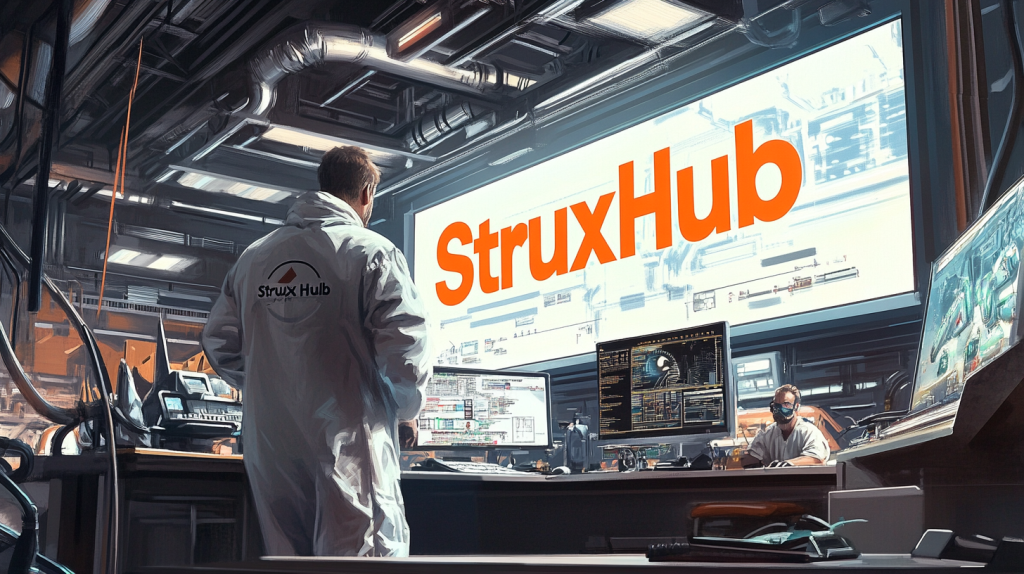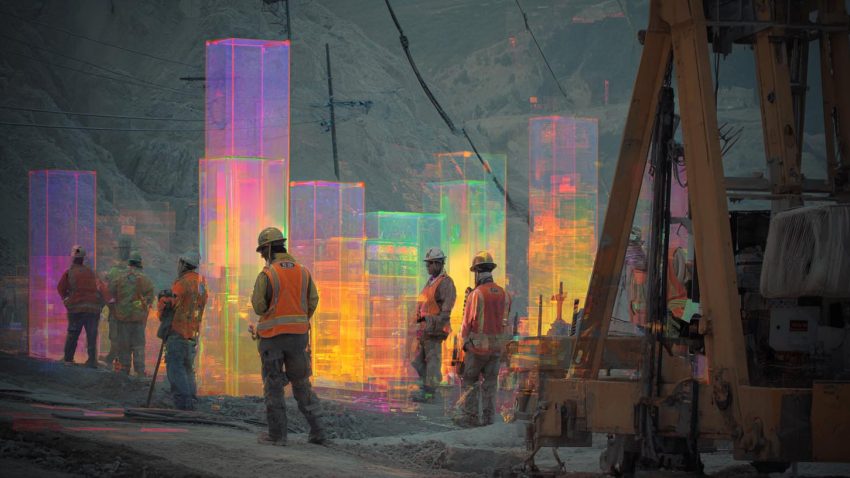Hyperscale Data Centers: Optimizing Multi-Tier Construction Scheduling for Seamless Project Execution
Table of Contents:

Building hyperscale data centers requires precise scheduling and coordination across multiple construction phases. These large-scale facilities must meet demanding uptime requirements, strict regulatory standards, and complex infrastructure needs, making effective multi-tier construction scheduling essential.
Without a well-structured plan, projects can suffer from supply chain bottlenecks, contractor misalignment, and extended timelines—all of which can increase costs and delay go-live dates. By implementing optimized scheduling strategies, predictive analytics, and real-time project tracking, decision-makers can streamline vendor coordination, improve resource allocation, and ensure timely project completion.
This guide covers the key scheduling strategies, industry best practices, and common challenges associated with hyperscale data center construction.
What is Multi-Tier Construction Scheduling in Hyperscale Data Centers?
Hyperscale data centers are the backbone of modern cloud computing, artificial intelligence, and global digital infrastructure. These massive facilities require intricate planning and execution, with construction schedules that must align multiple tiers of development—civil works, electrical infrastructure, HVAC systems, and IT deployment. Unlike traditional data centers, hyperscale builds demand a highly coordinated, multi-phase construction approach to keep projects on track while managing hundreds of vendors, suppliers, and subcontractors.
Without an optimized scheduling framework, these projects face supply chain disruptions, inefficient labor allocation, and workflow bottlenecks that delay delivery and increase costs. Multi-tier scheduling is essential for mitigating risks, ensuring synchronized execution, and keeping every stakeholder aligned with project milestones. Platforms like StruxHub provide real-time coordination tools that enhance efficiency by integrating vendor logistics, automated scheduling, and workflow tracking. This guide explores how to optimize hyperscale data center construction schedules, overcome common challenges, and implement best practices that improve project outcomes.
Related Articles:
Sustainable Data Center Construction: Best Green Building Practices for Sustainable and Mission-Critical Data Center Construction
Data Center Construction Compliance: Top Tools for Streamlining Permits and Compliance in Data Center Construction
Data Center Construction Delivery Coordination: Efficient Scheduling Strategies for Modular Data Center Equipment Installations

What is Multi-Tier Construction Scheduling in Hyperscale Data Centers?
Multi-tier construction scheduling is a structured approach to managing different phases of hyperscale data center development. Unlike traditional construction, where tasks follow a linear progression, hyperscale projects require multiple phases to run concurrently to accelerate timelines while maintaining quality control. These projects involve various workstreams, including site preparation, structural assembly, electrical system deployment, cooling infrastructure, and IT installation. Each of these must be carefully sequenced to avoid inefficiencies and delays.
A well-planned multi-tier schedule ensures that different teams—civil engineers, electrical contractors, HVAC specialists, and network integrators—work in a coordinated fashion without interfering with one another. Advanced scheduling platforms, such as StruxHub, allow teams to track progress in real-time, identify scheduling conflicts, and adjust workflows dynamically based on project needs. By implementing structured milestone tracking and integrating predictive scheduling tools, hyperscale data centers can achieve faster time-to-market, reduce construction costs, and improve resource efficiency.
Key Components of Multi-Tier Scheduling:
- Phase-Based Execution: Breaking the project into manageable tiers, including foundation work, shell construction, mechanical systems, and IT integration.
- Parallel Workflows: Ensuring multiple vendors can work simultaneously without conflicts.
- Critical Path Management (CPM): Identifying and prioritizing tasks that directly impact the final completion date.
By aligning construction phases with procurement, vendor coordination, and deployment milestones, teams can eliminate scheduling inefficiencies and reduce overall project duration.
What Are the Biggest Challenges in Hyperscale Data Center Scheduling?
Coordinating a hyperscale data center build comes with significant challenges. The complexity of these projects means that even minor scheduling delays can have cascading effects on the entire construction timeline. One of the biggest challenges is vendor coordination, as multiple suppliers and subcontractors must work simultaneously without interfering with other critical construction phases. Any misalignment in scheduling can result in workflow bottlenecks, leading to costly rework and extended project durations.
Another common issue is supply chain disruptions, particularly for key components such as high-density cooling systems, power distribution units, and fiber optic cabling. These delays can slow down progress, as certain installations must be completed before the next phase can proceed. Regulatory compliance adds another layer of complexity, with hyperscale facilities needing to meet strict certification standards, including Uptime Institute Tier certifications and ANSI/TIA-942 requirements. Ensuring that all vendors and materials comply with these regulations requires meticulous planning and documentation.
Additionally, integrating IT infrastructure with facility construction poses unique challenges. Unlike conventional buildings, where IT equipment is deployed after the structure is complete, hyperscale data centers require parallel coordination between construction teams and IT specialists. Ensuring that electrical, networking, and server deployment align with cooling and power infrastructure schedules is essential for maintaining project momentum. StruxHub helps solve these challenges by providing a centralized platform for vendor coordination, material tracking, and compliance management, ensuring smoother project execution
1. Vendor Coordination & Workflow Conflicts
Hyperscale data centers involve multiple specialized contractors, from structural engineers to electrical teams. Poor scheduling can result in worksite congestion, delays, and workflow bottlenecks.
2. Supply Chain Delays & Material Shortages
Delays in HVAC systems, backup generators, fiber optic cabling, or networking equipment can halt progress on critical installations. Without an adaptive procurement strategy, these shortages can create severe timeline setbacks.
3. Strict Compliance & Inspection Requirements
Hyperscale facilities must meet stringent standards like Uptime Institute Tier Certifications, ASHRAE cooling guidelines, and ANSI/TIA-942 regulations. Delays in inspections, compliance approvals, or rework due to non-conformance can push back key milestones.
4. IT & Power Infrastructure Integration
Unlike standard construction projects, hyperscale builds must synchronize hardware deployment with facility readiness. Power systems, cooling infrastructure, and networking equipment must be deployed in precise sequence to avoid operational risks.
By addressing these challenges proactively, project teams can enhance efficiency and prevent costly setbacks.
Related Articles:
Best Guide to Data Center Construction Management Software: Manage Scheduling, Deliveries, and Compliance for Hyperscale Projects
Data Center Construction Deliveries: Best Real-Time Tracking Solutions for Managing Data Center Construction Deliveries
Data Center Construction: Top Delivery and Scheduling Strategies for Redundant Power Systems in Data Centers

How Can AI and Predictive Analytics Improve Construction Scheduling?
Artificial intelligence (AI) and predictive analytics are transforming hyperscale data center construction by introducing data-driven decision-making into scheduling processes. AI-driven scheduling tools analyze historical data, project dependencies, and resource availability to identify potential bottlenecks before they occur. This allows project managers to make proactive adjustments, reducing the risk of delays and cost overruns.
One major advantage of AI-powered scheduling is its ability to optimize labor allocation. Predictive models can assess workforce productivity levels and adjust scheduling based on real-time conditions, ensuring that teams are deployed efficiently. Additionally, AI can track supply chain trends and predict material shortages, allowing project managers to adjust procurement strategies accordingly. This is particularly useful in hyperscale construction, where delays in critical components—such as HVAC systems or high-density storage units—can derail entire project timelines.
By integrating AI and predictive analytics into scheduling platforms like StruxHub, construction teams gain access to real-time insights that improve scheduling accuracy, optimize resource distribution, and enhance risk management. AI-driven automation reduces the administrative burden on project managers, freeing them to focus on strategic planning and execution. The result is a more streamlined, cost-effective construction process that ensures hyperscale data centers are delivered on time and within budget.
AI-Driven Scheduling Benefits:
- Predictive Risk Analysis: AI algorithms analyze past project data to identify potential scheduling conflicts before they occur.
- Automated Workflow Adjustments: AI can dynamically adjust timelines when supply chain disruptions or weather-related delays impact progress.
- Enhanced Labor Productivity: AI-powered tracking systems optimize workforce scheduling, ensuring labor teams are assigned based on demand fluctuations.
By implementing AI-driven insights, project managers can reduce scheduling risks, improve efficiency, and accelerate project completion.
What Are the Best Practices for Optimizing Hyperscale Construction Timelines?
To achieve efficiency in hyperscale data center construction, project managers must implement proven scheduling strategies that minimize delays and enhance collaboration among stakeholders. One of the best practices is adopting an integrated scheduling platform that consolidates project timelines, vendor coordination, and resource allocation into a single dashboard. StruxHub provides a comprehensive solution that enables teams to track progress, automate scheduling adjustments, and ensure seamless communication between contractors and suppliers.
Another key practice is optimizing supply chain logistics. Just-in-Time (JIT) procurement reduces on-site material storage challenges while ensuring that necessary components arrive precisely when needed. Pre-qualifying multiple suppliers helps mitigate risks associated with supply chain disruptions, allowing projects to adapt quickly to unexpected shortages. Modular construction is also an effective strategy, as prefabricated components can be assembled off-site and installed rapidly, significantly reducing on-site labor requirements.
By leveraging data-driven decision-making, integrating construction management software, and maintaining strong vendor relationships, project managers can optimize hyperscale data center construction schedules and ensure that projects are completed efficiently. These best practices not only accelerate project timelines but also enhance cost control, quality assurance, and overall project execution.
1. Implement an Integrated Scheduling Platform
A centralized scheduling system improves real-time tracking, automates task prioritization, and enables data-driven decision-making. Tools like StruxHub, Procore, and Autodesk Build offer:
- Automated milestone tracking.
- Live vendor coordination dashboards.
- Predictive risk assessment models.
2. Align Supply Chain Logistics with Project Timelines
Ensuring materials arrive exactly when needed prevents costly delays and inventory mismanagement. Key strategies include:
- Just-in-Time (JIT) Procurement: Reducing storage costs while ensuring on-time material delivery.
- Pre-qualifying multiple suppliers to create a redundant supply chain.
3. Use Modular Construction & Prefabrication
Modular construction techniques accelerate deployment by assembling prefabricated components off-site. This approach:
- Reduces on-site labor requirements.
- Cuts construction timelines by up to 30%.
- Improves quality control through off-site standardization.
Implementing these strategies ensures that hyperscale projects meet aggressive construction deadlines without compromising quality or efficiency.

How Do Commissioning & Final Testing Fit Into the Schedule?
Commissioning and final testing are critical phases in hyperscale data center construction, ensuring that all systems—mechanical, electrical, cooling, and IT infrastructure—function optimally before the facility goes live. Unlike traditional buildings, where final inspections are conducted near completion, data center commissioning is an ongoing process that begins during early construction phases. This approach minimizes risks, prevents system failures, and ensures compliance with industry standards.
The commissioning process is typically divided into five levels. Level 1 focuses on equipment procurement and manufacturer testing, ensuring components meet performance specifications. Level 2 involves installation verification, ensuring that electrical and mechanical systems are properly integrated. Level 3 moves into functional testing, where backup power systems, cooling infrastructure, and fire suppression systems are tested under simulated loads. Level 4 escalates into full-load testing, replicating real-world scenarios to evaluate system resilience under maximum demand. Finally, Level 5 consists of integrated systems testing, where all components—power distribution, networking, security, and environmental controls—are validated for seamless operation.
Delays in commissioning can have significant financial consequences, as any issue detected at this stage requires rework that may push back launch timelines. To avoid disruptions, project managers use advanced scheduling platforms like StruxHub to track commissioning progress in real time, ensuring that each phase is completed on schedule and that all stakeholders remain aligned. Automated workflows allow teams to identify potential roadblocks early, ensuring that inspections, compliance approvals, and equipment verifications are conducted efficiently. By integrating commissioning into the construction schedule, hyperscale data centers can achieve faster deployment, reduce operational risks, and ensure a seamless transition to full capacity.
Key Steps in the Commissioning Process:
- Level 1-3 Testing: Individual system testing to verify compliance with operational standards.
- Full-Load & Power Failover Simulations: Stress-testing infrastructure to ensure redundancy systems perform under real-world conditions.
- Final Tier Certification Approval: Facilities seeking Uptime Institute Tier III or IV Certification must pass rigorous commissioning audits.
A well-planned commissioning schedule prevents unexpected operational failures, reduces downtime risks, and ensures seamless facility handover.
What Role Does StruxHub Play in Optimizing Hyperscale Construction Scheduling?
StruxHub plays a vital role in optimizing hyperscale data center construction by centralizing scheduling, automating workflow management, and improving vendor coordination. Unlike traditional scheduling methods that rely on static Gantt charts and manual tracking, StruxHub provides real-time project visibility, enabling stakeholders to make data-driven decisions that enhance efficiency and reduce delays.
One of the biggest advantages of StruxHub is its ability to integrate multi-tier construction scheduling into a single platform. Hyperscale data center projects require seamless coordination across multiple workstreams, from civil engineering to IT infrastructure deployment. StruxHub allows teams to track these phases in real time, ensuring that structural, mechanical, and electrical systems align with IT deployment milestones. With automated scheduling adjustments, project managers can quickly reallocate resources when unexpected issues arise, preventing delays and keeping workflows on track.
Supply chain optimization is another key feature that enhances project efficiency. StruxHub enables real-time tracking of material deliveries, ensuring that critical components such as power distribution units, HVAC systems, and network cabling arrive precisely when needed. By integrating predictive analytics, StruxHub helps mitigate supply chain risks by forecasting potential shortages and suggesting alternative sourcing options before delays occur.
StruxHub also improves communication and collaboration by providing a centralized portal where contractors, vendors, and project managers can access updated schedules, track progress, and resolve issues efficiently. Instead of relying on fragmented email chains and manual reporting, all stakeholders have access to real-time data, streamlining decision-making and enhancing project accountability. With its robust automation, data-driven scheduling, and intelligent risk management tools, StruxHub is an essential platform for optimizing hyperscale data center construction, ensuring projects are completed on time, within budget, and at the highest quality standards.
StruxHub’s Key Benefits:
- Automated Scheduling & Progress Tracking: Ensures tasks remain on schedule, reducing project delays.
- Live Vendor Coordination Dashboards: Keeps all stakeholders informed with real-time updates.
- AI-Driven Supply Chain Optimization: Predicts material shortages and adjusts procurement strategies accordingly.
By integrating StruxHub’s intelligent scheduling platform, construction teams can accelerate timelines, enhance collaboration, and eliminate inefficiencies.

Unlock the Full Potential of Your Construction Projects with StruxHub
StruxHub enhances efficiency and coordination across all project phases, providing a single source of truth that eliminates silos and fosters collaboration. Real-time updates, financial management tools, and seamless commvunication features ensure that all team members and stakeholders are aligned and informed, reducing the risk of errors and delays. With comprehensive solutions for document management, risk mitigation, and quality control, StruxHub maintains project integrity and safety, while mobile access and integration capabilities further enhance project flexibility and efficiency.
StruxHub’s Key Features and Benefits:
- Advanced Delivery Management: Automate and optimize your delivery schedules, ensuring materials arrive just in time, every time.
- Site Communication: Utilize georeferenced maps and instant messaging to keep every team member informed and aligned.
- Construction Materials Management: Track inventory levels and manage materials procurement with ease, reducing waste and avoiding project delays.
- Construction Safety & Inspection Workflows: Implement customizable mobile forms for conducting safety inspections and managing compliance documentation effortlessly.
- Short-Term Scheduling: Visualize project tasks with detailed floor plans, linking each activity to specific locations for better planning accuracy.
- Construction Resource Management: Efficiently allocate personnel and equipment, maximizing productivity and reducing idle time.
StruxHub’s Product Offering:
- StruxHub Deliveries: Simplifies the coordination of incoming deliveries, ensuring materials and equipment are precisely timed to project needs.
- StruxHub Logistics: Offers intelligent site logistics planning, from crane scheduling to space allocation, for smoother operations.
- StruxHub Safety: Elevates on-site safety standards with easy-to-use tools for inspections, permits, and incident reporting.
- StruxHub Scheduling: Enhances project timelines with intuitive scheduling tools that ensure tasks are completed efficiently and on time.
With StruxHub, construction companies can look forward to a streamlined, more efficient project execution that delivers on time and within budget. Embrace the power of innovation and take your construction projects to the next level.
Don’t miss out on the opportunity to optimize your construction management processes with StruxHub. Sign up for a free demo today. Let’s build smarter, together.

StruxHub
Experience the power of StruxHub today and witness firsthand how it can revolutionize your construction operations.
FAQ
1. How do supply chain disruptions affect hyperscale data center construction?
Supply chain disruptions can significantly impact the construction schedule of a hyperscale data center, leading to cost overruns, delayed project timelines, and inefficiencies across multiple workstreams. Hyperscale data centers require specialized components such as power distribution units, precision cooling systems, high-density networking equipment, and structural steel. A delay in any of these materials can cause cascading effects throughout the project, forcing teams to push back installations, reschedule vendors, or even halt progress until key materials arrive.
One of the biggest risks is dependency on a single supplier or geographic region for critical components. A shortage of specialized transformers or backup generators, for example, can put electrical system deployment on hold, delaying IT infrastructure installation. To mitigate these risks, project managers use proactive procurement strategies, such as diversifying supplier networks, securing priority contracts with manufacturers, and maintaining an inventory buffer for high-risk components.
Technology also plays a role in minimizing the impact of supply chain disruptions. Platforms like StruxHub provide real-time material tracking, ensuring that project managers can monitor shipments, receive alerts for potential delays, and adjust schedules accordingly. Predictive analytics integrated into construction management software can help teams anticipate potential shortages before they occur, allowing for alternate sourcing strategies. By leveraging data-driven supply chain management, hyperscale data center projects can reduce disruptions, maintain workflow efficiency, and ensure critical infrastructure is installed on time.
2. What’s the biggest scheduling challenge in hyperscale data center projects?
One of the most complex challenges in hyperscale data center construction is managing multi-tier scheduling across multiple vendors, subcontractors, and project phases. Unlike traditional construction projects, where activities often follow a linear timeline, hyperscale data centers require parallel workstreams to keep up with aggressive deployment schedules. This complexity increases the likelihood of scheduling conflicts, workflow bottlenecks, and resource misallocations that can delay overall project completion.
One common challenge is aligning mechanical, electrical, and IT infrastructure installations. For example, the cooling system must be installed and tested before server racks can be deployed. However, if HVAC installations fall behind due to supply chain delays, IT teams may be forced to reschedule or work in suboptimal conditions, impacting the data center’s reliability. To address these issues, project managers rely on construction scheduling software that integrates real-time tracking, automated milestone adjustments, and predictive analytics.
Another challenge is vendor coordination, as hyperscale projects involve multiple suppliers working simultaneously. StruxHub allows teams to streamline vendor communication by providing a centralized scheduling platform where contractors and suppliers can update progress, resolve scheduling conflicts, and receive automated alerts when tasks are completed or delayed. This transparency ensures that every workstream stays aligned with the broader construction schedule. By optimizing scheduling workflows and reducing inefficiencies, hyperscale data center projects can meet tight deadlines without compromising quality.
3. How does modular construction impact scheduling?
Modular construction has become a game-changer in hyperscale data center development by reducing build times, improving quality control, and enhancing scheduling efficiency. Unlike traditional on-site construction, modular construction involves pre-fabricating key components—such as electrical and cooling systems, server enclosures, and mechanical skids—off-site in a controlled manufacturing environment. These preassembled units are then transported to the data center site for rapid installation, reducing overall project timelines.
One of the primary advantages of modular construction is its ability to streamline scheduling by eliminating dependencies between workstreams. In a conventional data center build, mechanical, electrical, and IT infrastructure installations must be completed sequentially. However, with modular construction, these systems are assembled in parallel off-site while site preparation, foundation work, and structural assembly occur on-site. This parallel workflow significantly reduces overall project duration, allowing hyperscale data centers to become operational faster.
Additionally, modular construction minimizes weather-related delays and workforce scheduling conflicts. Because critical infrastructure is manufactured in controlled environments, there is less risk of delays due to labor shortages, permitting issues, or on-site material shortages. Platforms like StruxHub further enhance modular scheduling by integrating supply chain tracking, automated workflow adjustments, and real-time vendor coordination, ensuring seamless integration between off-site manufacturing and on-site assembly. By leveraging modular construction, data center developers can increase efficiency, enhance scalability, and reduce costs associated with traditional construction inefficiencies.
4. How can AI improve data center construction scheduling?
Artificial intelligence (AI) is revolutionizing data center construction scheduling by introducing automation, predictive analytics, and real-time optimization. Traditional scheduling methods rely on manual adjustments and historical project data, which can lead to inefficiencies and errors. AI-driven scheduling tools, on the other hand, analyze vast amounts of data to identify potential risks, optimize resource allocation, and predict delays before they occur.
One of AI’s most impactful applications is predictive risk management. AI-powered platforms analyze historical project timelines, labor productivity rates, and supply chain trends to forecast potential scheduling disruptions. If an upcoming material shipment is delayed, AI can automatically adjust task sequences, recommend alternative suppliers, or suggest schedule modifications to prevent project delays. This proactive approach minimizes downtime and ensures workstreams continue without disruption.
AI also enhances labor efficiency by dynamically assigning workforce resources based on real-time demand. For example, if one subcontractor finishes ahead of schedule, AI can reallocate labor to another high-priority task, optimizing productivity. Additionally, AI-driven scheduling platforms like StruxHub integrate machine learning algorithms that continuously refine project timelines based on live performance data, ensuring that schedules remain adaptive and efficient throughout the project lifecycle. By implementing AI-driven scheduling solutions, hyperscale data center developers can improve project predictability, enhance coordination, and deliver data centers on time and within budget.
5. How does StruxHub enhance scheduling efficiency?
StruxHub is designed to optimize scheduling efficiency in hyperscale data center construction by providing real-time project tracking, vendor coordination, and automated workflow management. Traditional scheduling methods rely on manual updates, fragmented communication, and static project timelines that make it difficult to adapt to unexpected delays. StruxHub addresses these challenges by offering a centralized platform where all stakeholders—contractors, suppliers, project managers—can access live scheduling data, ensuring alignment across every phase of construction.
One of the key features of StruxHub is its ability to automate milestone tracking and workflow adjustments. When a vendor completes a task or a shipment arrives on-site, StruxHub updates the project timeline in real time, notifying relevant teams and triggering next-phase actions. This eliminates bottlenecks caused by miscommunication and ensures that dependencies between workstreams are managed efficiently.
StruxHub also integrates predictive analytics, allowing project managers to anticipate potential delays before they impact the construction timeline. By analyzing historical data, supply chain trends, and workforce productivity, the platform provides early warnings about scheduling risks, enabling proactive decision-making. Additionally, StruxHub enhances vendor coordination by offering a transparent communication portal where suppliers can update delivery statuses, report issues, and receive automated alerts when project requirements change.
By leveraging StruxHub’s real-time scheduling tools, hyperscale data center developers can reduce inefficiencies, improve project visibility, and ensure seamless coordination across all construction phases. This level of automation and predictive intelligence helps projects stay on track, reducing costs and minimizing the risk of unexpected delays.




